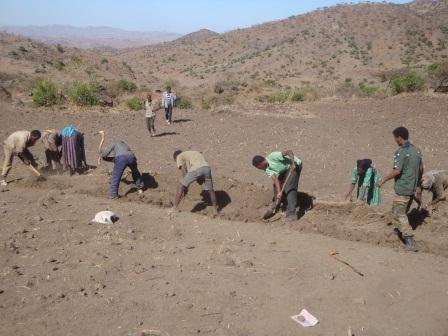Climate Change Adaptation Strategies from Rural Ethiopia: Does Social Protection Help?
Background
Ethiopia ranks 10th in the list of countries most at risk from climate change in 2014, according to the Climate Change Vulnerability Index, prepared by Maplecroft. The low-level of development and dependence on agriculture are the main reasons for this vulnerability. Agriculture is the mainstay of the country?s economy contributing 50% of its GDP and employing 85% of its population. The majority of farmers are smallholders that depend on rain-fed agriculture for subsistence. These smallholders face numerous challenges and struggle to make ends meet and even a slight change in the weather pattern could turn into a major catastrophe of the kind that is seen in the mid-1980s. Most climatic models also predict a change in the climate, which will have an adverse impact on the agricultural sector and worsen the food insecurity problem.
The Productive Safety Net Program (PSNP) is one of the largest social protection programs in Africa. It was launched by the Government of Ethiopia and a group of donors in 2005 to address the needs of food insecure households through ?multi-year predictable resource transfers?, a break from the earlier tradition of relying on emergency food aid. It has two components: labor-intensive public works and direct support. Most beneficiaries participate in public works to enhance community assets, such as building or maintaining roads, watershed structures, terraces etc.
Many social protection programs have targeted and contributed to the efforts of reducing vulnerability associated with variations and extremes in climate and their impact on rural livelihoods. As a result, there is a growing recognition of the role of social protection programs in addressing climate-related shocks and vulnerabilities. However, little empirical evidence exists about the extent and conditions by which such schemes are able to contribute to autonomous climate change adaptation at the household level. This type of adaptation is particularly critical in poor countries like Ethiopia as they cannot afford the high cost of planned adaptation measures that require huge investments in infrastructure and technologies.

Photo Credit: Courtesy of Habtu Darge from Lasta District Disaster Risk Management and Food Security Coordination office.
Public Work participant farmers in Shumsheha village undertaking soil and water conservation work, May, 2013.
Can Social Protection Promote Positive Adaptation Strategies?
My study examines the impacts of the PSNP on autonomous adaptation strategies by taking the case of household income diversification, which is considered as one of the major autonomous adaption strategies in rural Africa. An increase in non-farm income is taken as a sign of positive adaptation by subscribing to the argument that diversifying into non-farm activities is preferable to activities tied to farming. The study uses non-experimental approaches (i.e., Difference-in-Differences combined with Propensity Score Matching and quintile regression) for a panel of 1306 rural households from the two recent rounds of the Ethiopian Rural Household surveys (ERHS) for the years 2004 and 2009. The results indicate that receiving transfers from the PSNP, on average, increases income from non-farm activities. This supports the hypothesis that social protection can promote positive adaptation strategies and could serve as an effective means of reducing the vulnerability of smallholders to climate change induced shocks.
However, given the strong link between agricultural growth and the expansion of the non-farm sector, as evidenced by the south Asian experience, it is reasonable to assume that achieving long-term and sustainable adaptive capacity requires supporting the farming sector. This in turn begs the question, how and to what extent the current form of social protection can maintain diversification as a viable form of adaptation strategy? Specifically, how well can the PSNP integrate with other initiatives such as weather-index insurance? And how does this contribute to the expansion of the non-farm sector?
Any comments and suggestions on this study are highly appreciated and will be taken into consideration for the final version which will be completed by April 2015.
Zerihun B. Weldegebriel is a PhD candidate at the University of Trento in the International Doctoral School of Local Development and Global Dynamics, Italy. He studied Globalization and Development (University of Antwerp, Belgium) and Rural livelihoods and Development (Addis Ababa University, Ethiopia). He has worked as a Lecturer at University of Gondar and as a Project officer in a Non-Governmental Organization in Ethiopia. His research areas include climate change adaptation, social protection, and livelihoods systems.



